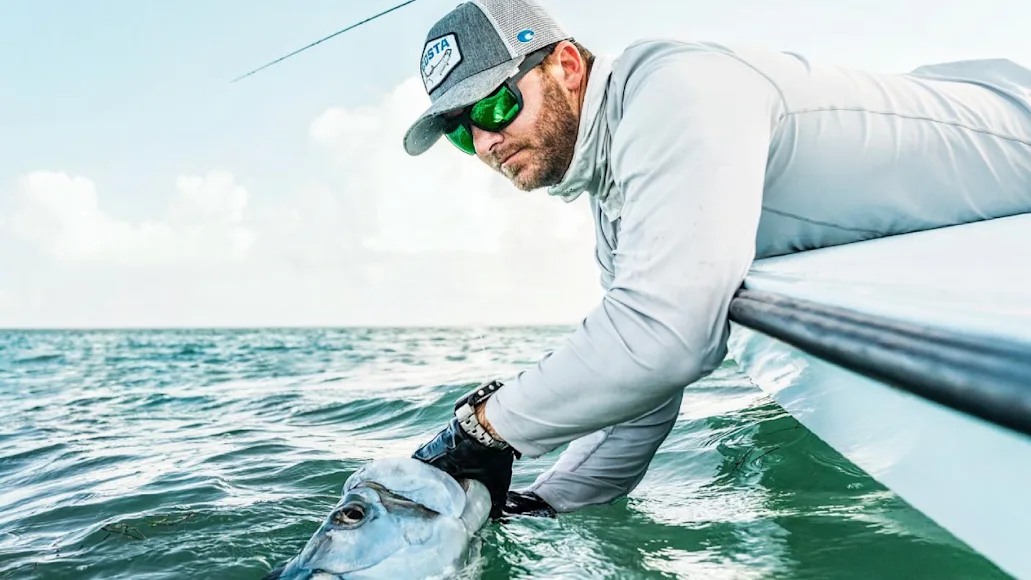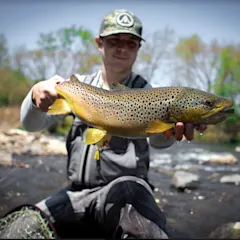We may earn revenue from the products available on this page and participate in affiliate programs. Learn more
Along with a quality rod and reel and some waterproof fishing boots, every angler needs a good pair of fishing sunglasses. Sunglasses serve several key functions that help you catch fish and keep you safe and comfortable during your time on the water. Not only do they provide UV and sun protection, but if you get a polarized pair, they can reduce the surface glare on the water and help you spot fish more easily.
Beyond that, they are a critical piece of safety gear. Wearing shades while fishing can prevent a stray hook from being embedded in your eye, saving you a trip to the ER and even permanent eye damage. This means that you absolutely don’t want to hit the water without your sunglasses.
To find the top performing pairs for any style of angling—whether you’re offshore, inshore, or fly fishing—I took glasses from brands like Costa, Smith, and Oakley out on the water. After a week of long days on the boat in Florida, here’s how the best fishing sunglasses stacked up.
Best Overall: Costa Grand Catalina
Best Polarized: Costa Blackfin 580G
Best Fly Fishing: Smith Hookset
Best Inshore: Bajio Sigs
Best Offshore: Oakley Gascan
Best Saltwater: Smith Redding ChromaPop
Most Comfortable: Costa Fantail
Most Sustainable: Costa Santiago
Best Under $100: KastKing Skidaway
Best Overall: Costa Grand Catalina
Specs
Frame Fit: XL
Lens Color: Gold Mirror Polarized Glass
Prescription Lenses: Yes
Pros
Built-in sweat channels and venting
Removable side shields
Excellent at cutting through glare on shallow water flats
Can be worn as lifestyle shades without side shields
Cons
XL frame may be big for some

Costa’s newest frame, the Grand Catalina, is a modernized version of a classic. There’s a chance you’ve seen the originals worn by the likes of Flip Pallot, Stu Apte, and many other fishing legends. This new version took the original lenses and paired them with the best technology Costa had to offer. This includes removable side shields, built-in sweat channels, and anti-fogging ventilation groves.
On a recent trip to the Florida Keys, I wore the Grand Catalinas with Gold Mirror Glass Lenses, and the performance was impressive. Of all the shades I wore, the Grand Cats cut through glare on shallow water flats the best, revealing stringing tarpon sliding over the flats. I attribute this to the unique colored glass, making fish pop, and the sun shields blocking out light from the sides.

In the Keys, eye protection is a must. The combination of sun shields and quality polarized glass protects your eyes from harmful UV rays and minimizes eye fatigue. When you’re off the water, the sun shields are removable, giving these glasses a lifestyle look, perfect for an all-in-one pair of sunglasses.
Best Polarized: Costa Blackfin 580G
Specs
Frame Fit: Large
Polarized: Yes
Prescription Lenses: Yes
Pros
Comfortable for all-day wear
Great visibility
Stylish fit
Cons
Price
Costa Blackfin 580G Polarized Sunglasses are a high-quality option for serious anglers. The well-made lenses provide 100% protection from UV A, B, and C rays. The TR-90 nylon frame provides more than enough coverage to reduce glare off the water. The polarized lenses utilize 580G LightWAVE® glass lenses that filter out harsh yellow and blue light to make your vision clearer.
Like most of the Costa Del Mar sunglasses designs, the Blackfins have a prescription option available. The option to have either blue or green lenses provides the consumer with a slightly more customizable pair of glasses. Not all frame styles or lens colors have the same type of polarization, so pay close attention when choosing the one you want. Overall, these are high-quality pairs of sunglasses. They will be comfortable for all-day wear and provide the level of protection that anglers of all skill levels can appreciate.
Best Fly Fishing: Smith Hookset
Specs
Frame Fit: Medium
Lens Color: ChromaPop Glass PolarChromic Brown Green Mirror
Prescription Lenses: Yes
Pros
Lightweight and comfortable
Adaptive lens technology for changing light conditions
Built-in lanyard
Cons
Expensive
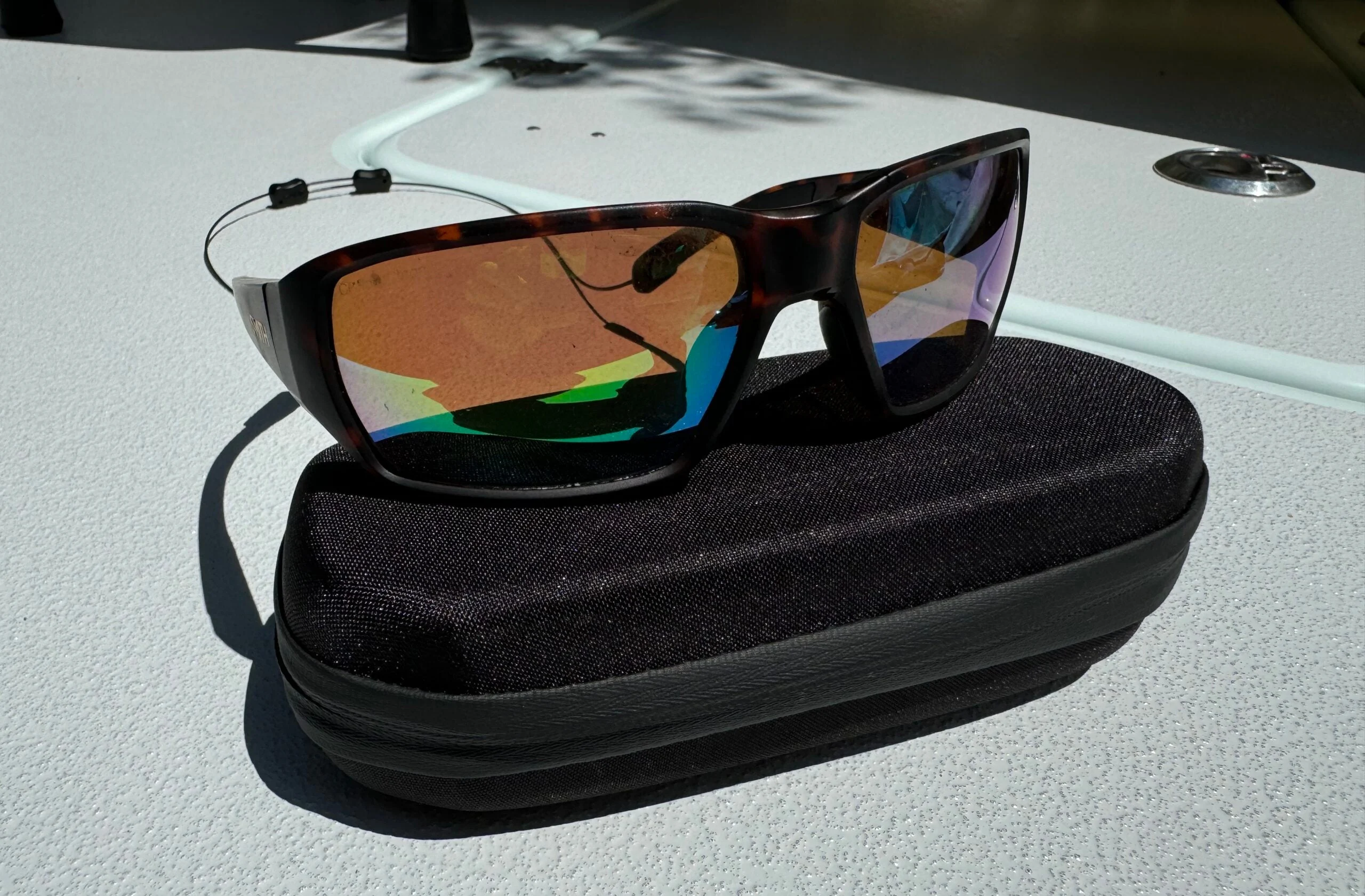
Smith recently unveiled its newest lens technology, PolarChromic glass. It’s a combination of multiple lens colors that automatically adjusts to changing light conditions. This lens tech is currently available in Brown Green Mirror and Yellow Blue Mirror colors. I opted for the Brown Green Mirror on the Hookset frames to better match the shallow water, inshore fisheries I target most. On the water, the tech is immediately apparent. From sunup to sundown, I was able to wear one pair of glasses. The lighter shades of brown shone through in low light conditions, shifting to a darker green mirror as the sun was overhead. The adaptability of a single polarized lens to change through variable conditions dramatically improves my ability to find fish.
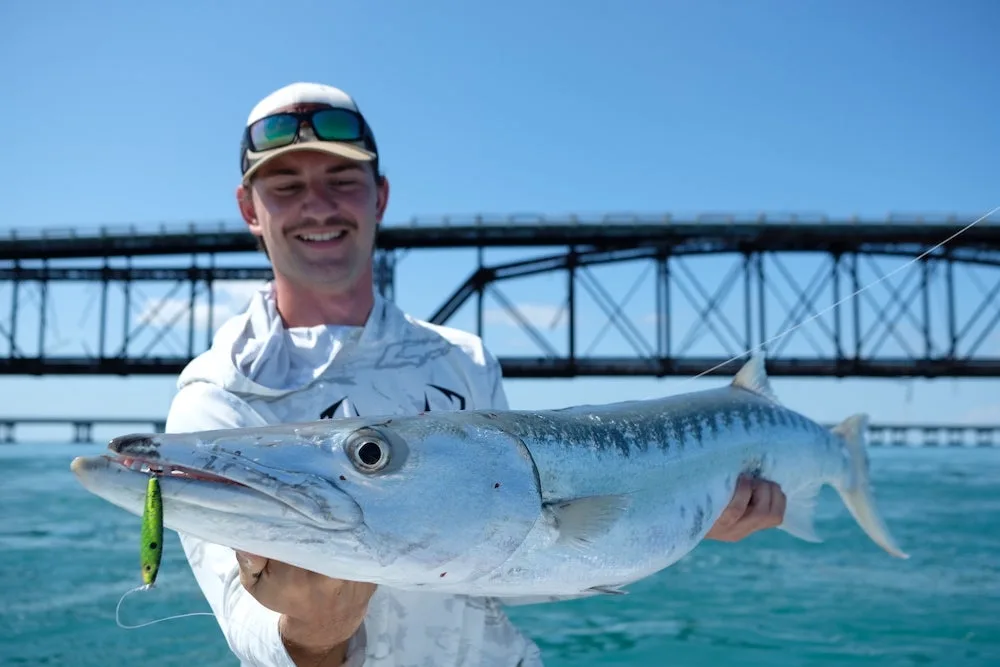
The Hookset frames I paired this with are comfortable and light. They come ready with a removable and adjustable backstrap, a nice feature to remove your shades when tying on new flies. The frames also feature wide sides to block ambient light and sweat grooves to prevent moisture from pooling.
Best Inshore: Bajio Sigs
Specs
Frame Fit: Medium
Lens Color: Green Mirror
Prescription Lenses: Yes
Pros
Lightweight feel
Fits snugly to face
Breathable
Cons
Thicker sides would block more light

Bajio is one of the newer brands in fishing sunglasses, but one that should be on every angler’s radar. Their glasses are comfortable, reasonably priced, and perform on the water. The new Sigs frames are no exception. On the water, these wrap snugly on my face, perfect for blocking out ambient light and showing fish.
They are available in several lens colors, but I opted for the green mirror glass lenses. This color excels in shallow water fishing with harsh overhead sun. Fish popped on the flats, giving us ample time to get in position for a cast. Despite being a glass lens, the Sigs are incredibly lightweight. I noticed little to no strain on my ears from wearing these frames all day on the water.
Best Offshore: Oakley Gascan
Specs
Frame Fit: One size fits all
Lens Color: Prizm Deep Water
Prescription Lenses: Yes
Pros
Full wrap to black out sun
Lens specific for offshore fishing
Lightweight feel
Cons
Limited frame and lens offerings
Oakley is a household name when it comes to sunglasses. Its recent offerings, including the Gascan, offer quality components tailored to anglers. The Gascan features a high-wrap frame construction. This means the frame wraps completely around your eyes and face to minimize the amount of light getting in from the sides. When offshore fishing, this is crucial with no natural shade around and harsh sunlight. Paired with Oakley’s Prizm Deep Water polarized lenses, the Gascan is the ideal offshore package. This specific color cuts through the unique glare found in deep water, enabling anglers to see fish in the depths below. Like other Oakley models, the Gascan features impact-resistant lenses. While this may not seem important, when hooks are flying and fish are jumping, this protects your eyes from stray objects.
Best Saltwater: Smith Redding ChromaPop
Specs
Frame Fit: small-medium
Polarized: yes
Prescription Lenses: N/A
Pros
Lens coating to repel moisture and grease
Variety of lens and style options
ChromaPop lenses
Impact-resistant
Cons
Varied lens protection depending on the style option
Price
The Smith Optics Redding ChromaPop Sunglasses provide impressive clarity for low-light fishing. The lenses are oil and water-resistant and feature an anti-reflective coating. These are a high-quality pair of polarized shades that are perfect for overcast days, as well as late-evening and early-morning outings.
Like many other Smith’s brand sunglasses, the price may be a bit high for some, but the quality makes most of them well worth the investment. We like the styles of almost all of their glasses options, but if you need something that excels in low light conditions, these glasses get the job done.
Most Comfortable: Costa Fantail
Specs
Frame Fit: Standard
Polarized: Yes
Prescription Lenses: Yes
Pros
Prescription lenses available
Scratch and impact resistant
Excellent warranty and customer service
Glass lenses provide exceptionally clear view
Cons
Older frame style seemed more durable
Glass lenses are more prone to scratches and damage
The Costa Del Mar Fantail Sunglasses are an excellent option if you want a versatile and unbeatably clear pair of sunglasses. Utilizing glass lenses, a clear view is guaranteed. It isn’t fair to compare glass to plastic when speaking about lenses, but it is worth mentioning that glass lenses are heavier and more prone to damage if dropped, so be aware of that before buying. Regardless, the lenses are still quite durable despite being glass.
The 580G LightWAVE® glass lenses filter out blue and yellow lights, improving overall vision and making colors brighter and objects more defined. The polarized lens also cuts glare which is necessary anytime you are enjoying time around water. It’s unlikely these will slip off your face with the snug fit. The Fantail design also has nose pads and temple tip inserts for an even more comfortable and secure feel.
Most Sustainable: Costa Santiago
Specs
Frame Fit: standard
Polarized: yes
Prescription Lenses: yes
Pros
Made from 97% recycled materials
580G polarized lenses
Secure and comfortable fit
Hooding and side shields for better light protection
Cons
No return or recycling program for old glasses
Making sustainable sunglasses is a tall order, and Costa Del Mar is making moves in the right direction. Their Untangled Collection uses recycled fishing nets to make the frames. While this isn’t a perfect solution, it is helping clear some plastic pollution from our oceans. What would be nice to see with all Costa Del Mar glasses is a return/recycling program of their own to reduce waste and create more circularity within the brand. It would also be nice to see them utilizing more recycled materials across all frame designs instead of just having one line of products.
Regardless, these glasses are effective and perform well. There are always ways we can improve and become more sustainable in our lives, and being intentional with our purchases is one of them. With three lens colors, glare protection, and light yet scratch-resistant lenses, it is nice to know that you’re investing in a pair of sunglasses that help protect the places you love.
Best Under $100: KastKing Skidaway
Specs
Frame Fit: Standard
Polarized: Yes
Prescription Lenses: N/A
Pros
Affordable price
Several design options
Works in both sunny and cloudy conditions
Impact resistant lenses
Cons
Not very durable
Seem to wear down easily around saltwater
KastKing Skidaway Polarized Sport Sunglasses feature a well-made frame and glare-reducing polarized lenses at an impressively low price point. The 1.0mm polarized lenses are comparable to many higher-priced offerings. This pair of sunglasses is a great option for any angler who’s on a budget.
How We Tested Fishing Sunglasses
Aside from rods and reels, sunglasses are arguably the most important piece of fishing gear. They protect your eyes on long days in the water and let you see fish through the water. To evaluate the best sunglasses, we tested the newest offerings from major brands for the year. This included new frames and new lens technologies. All shades in this test had to meet one requirement: they had to be polarized. Without polarization, the glasses would not cut through the water’s glare and reveal fish below.
With our test glasses in hand, I set out to the Florida Keys for a week of tarpon fishing. Stalking the flats in harsh sunlight and blistering heat is harsh on gear and the body–sunglasses are no exception. I rotated through pairs throughout the week, gauging each glass on its comfort, ability to spot fish, and overall eye strain.
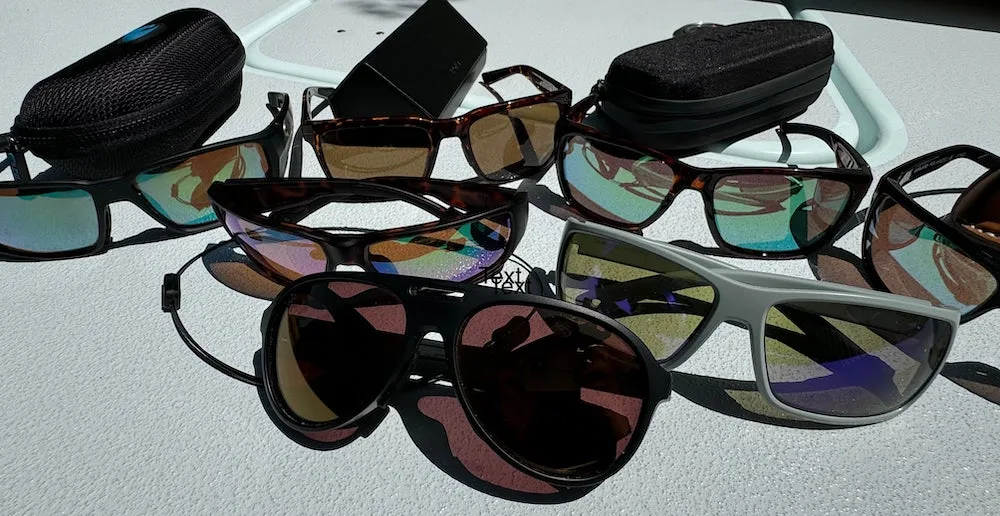
What To Consider When Choosing Fishing Sunglasses
You need to consider two main factors when looking for a new pair of fishing sunglasses: frame type and lens type. Both of these features impact how your fishing sunglasses will perform. The frame type is not just a matter of style. Your frame will also affect how well your sunglasses hold the lens in place and the amount of protection it offers. Similarly, your lens will affect both your glasses’ sun protection and visibility.
Polarized Lenses
Polarized lenses reduce glare by blocking all horizontal rays while still allowing vertical rays of light to pass through. Horizontal rays primarily reflect off of flat surfaces such as water or phone screens. This means that polarized sunglasses can drastically reduce surface glare and allow for sight fishing in situations that aren’t possible with normal sunglasses or no sunglasses. If you’re looking for a pair of the best fishing sunglasses, you need to consider polarized shades.
Polarized lenses differ from basic sunglass lenses, which do not filter out horizontal rays of light. Non-polarized lenses protect against UV rays and minimize glare, just not to the same extent as polarized lenses. For anglers who want the best possible fishing glasses, polarized lenses are a must.
Coverage
Fishing sunglasses need to provide sufficient coverage. What does this mean? Your sunglasses need to protect you not only from the sun that reaches you through the lenses, but also reduce the light that seeps in from the edges of your shades. For instance, if you wear square, Ray-Ban style shades, there will be a lot of excess light that finds its way through the sides and tops of your glasses. This will reduce both UV protection for your eyes, and potentially, your visibility. This problem can become especially dire when you’re fishing in the ocean or lakes that reflect a lot of extra light toward your eyes.
What kinds of sunglasses provide the best coverage? In short, sunglasses that fit closely to your face. This means that the frame will wrap around your eyes and feature thick temples which prevent excess light from reaching your eyes through the edges of your sunglasses. As always, fit of the glasses is critical. Ensure your sunglasses hug your face tightly without being so tight that they are uncomfortable to wear and give you a headache. The right wrap-around sunglasses will reduce glare and keep you fishing even on the brightest of days.
Light Conditions
Most sunglasses are meant for sunny conditions. But when you go fishing, it’s not always sunny out. You should still wear sunglasses because the safety component is vital. And even in overcast weather, the water surface will still emit a glare that can make it difficult to see your bobber or fly, which means that you might start missing strikes. If you spend a lot of time fishing at dusk or in inclement weather, consider purchasing a pair of sunglasses made specifically for low light conditions.
Low light lenses will either be clear or lightly colored. They probably won’t be mirrored like sunglasses designed for bright conditions. Be aware: many low light shades on the market are not polarized. Avoid these products if you can. You will still want to filter our horizontal rays that reduce the surface glare off the water.
Comfort
You know the saying: Look good, feel good, play good. The same motto applies to fishing. As with other types of outdoor apparel, your fishing sunglasses say a lot about you as an angler. You want to get a pair of fishing sunglasses that not only work well on the water, but that you also enjoy wearing.
Still, make sure to balance style with functionality. You might be comfortable reducing frame coverage to have a more traditional-looking style of shades. This should be fine so long as you aren’t fishing in extremely bright conditions. This give and take consideration is one that you need to make before buying a new pair of sunglasses. No matter what, don’t get non-polarized sunglasses. That will drastically reduce your sunglasses performance without impacting the style. Other than that, find the right balance between style and functionality. Then hit the water with confidence.
Price
Fishing sunglasses can be expensive. What do you get from pricey fishing sunglasses? Typically, a durable frame with lenses that offer superb visibility. The lenses will usually last a relatively long time so long as you do a good job protecting them from scratches. That said, one of the leading price factors of expensive sunglasses is the brand name. Sunglasses have some of the highest margins of any outdoor product, meaning they cost relatively little to produce compared to their final price tag. This means that a discerning shopper who doesn’t care about brand names should be able to find a high-quality pair of shades at a low price point.
When you’re on a budget, make sure that the shades you buy are polarized. This will take the cheapest sunglasses off of the table, but non-polarized lenses are a non-starter for most anglers. Beyond that, look for the same thing you’d look for in pricier sunglasses—sun protection and style. Then pull the trigger.
FAQs
Q: Blue or green lenses: what’s better for fishing?
Blue lenses are good for fishing in certain conditions. Most “blue” lenses are not actually blue but blue-tinted, meaning that the lens, which is typically gray, is coated with a blue mirror. This coating can provide some key benefits to anglers. The blue mirror blocks harsh glare, especially in bright conditions. Get a blue-tinted lens for sunny days on the water.
Q: Are polarized sunglasses worth it for fishing?
This is mainly a matter of personal preference and the type of fishing you do. So long as the lenses are polarized and provide enough coverage to protect your eyes from the sun, you can’t go wrong with polarized fishing sunglasses. Focus on finding a pair of sunglasses within your price range and that you’re comfortable wearing for long periods of time.
Q: What tint of sunglasses is best for fishing?
Brown, amber, copper, and rose-colored tinted lenses are often said to be the best for fishing because they are high-contrast. However, the type of fishing you are doing can change this. These high-contrast lens colors are ideal for inshore fishing, whereas a grey or blue lens is more commonly used for offshore fishing.
Q: Can you see through water with polarized sunglasses?
Yes, you should be able to see into the water with polarized sunglasses. Polarized lenses reduce the glare from light hitting the top of the water, giving you a clearer view down into the water. The color of the lens can also influence your ability to see through the water.
Q: What’s the difference between cheap and expensive fishing sunglasses?
There are often many differences between cheap and expensive fishing sunglasses. Two major differences are the tint/color and the lens material. High-quality sunglasses utilize a tint that enhances vision, whereas many cheap sunglasses darken the lens to make it appear tinted without providing any actual benefit. Many high-quality sunglasses have plastic lenses, but most expensive sunglasses are made with glass lenses that are scratch resistant and maximize visual clarity.
Q: What is “sight fishing”?
Sight fishing is when you spot fish in the water and then coax it towards your bait or lure. Having the proper eyewear can make this easier as it provides better visibility into the water, but sight fishing is still a difficult method to perfect.
Final Thoughts
The best fishing sunglasses are an essential piece of fishing gearand provide several vital functions. They protect your eyes from the sun and stray hooks while also enhancing your visibility. Every angler should own at least one good pair of polarized fishing sunglasses. The polarization blocks horizontal light rays and allows you to peer beneath the surface of the water. Owning a comfortable and good-looking pair of fishing shades is a must for any angler.
Why Trust Us
For more than 125 years, Field & Stream has been providing readers with honest and authentic coverage of outdoor gear. Our writers and editors eat, sleep, and breathe the outdoors, and that passion comes through in our product reviews. You can count on F&S to keep you up to date on the best new gear. And when we write about a product—whether it’s a bass lure or a backpack—we cover the good and the bad, so you know exactly what to expect before you decide to make a purchase.

